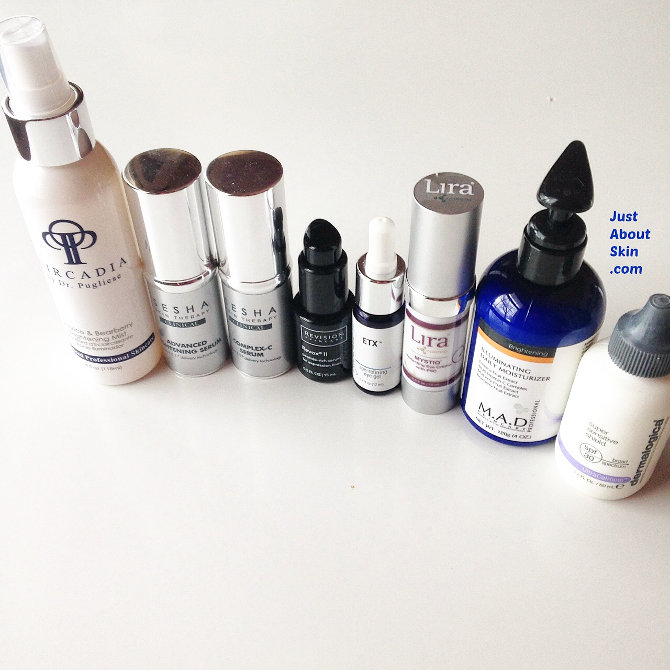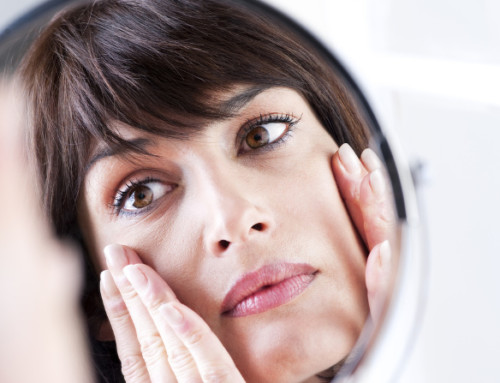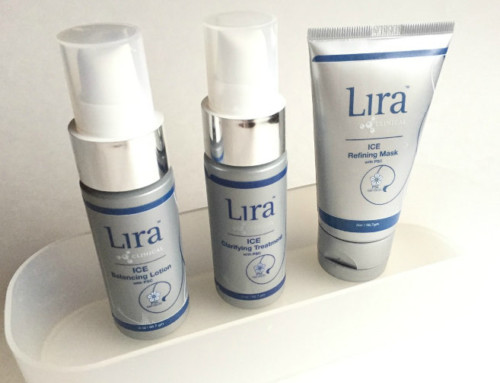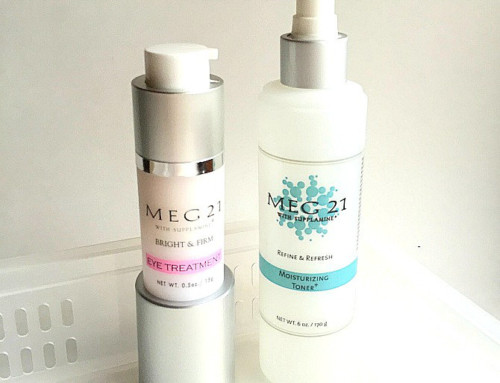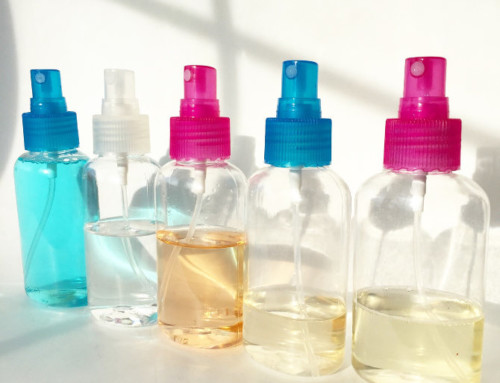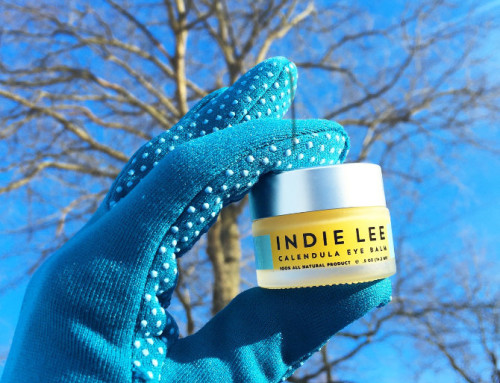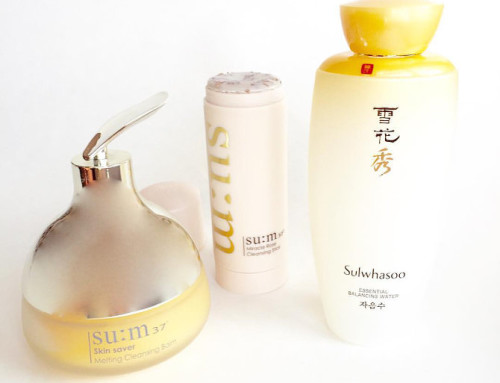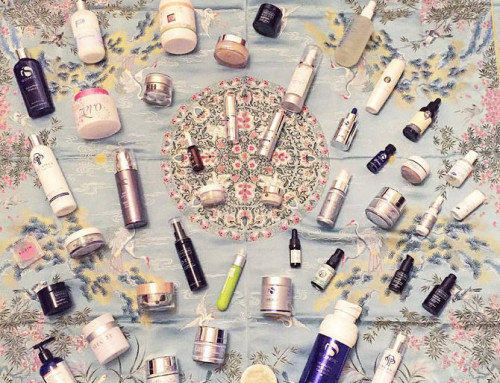This was today’s morning anti-aging skincare routine. It’s a routine constructed entirely of professional skincare brands.
I realize that many of you may not be familiar with or have access to professional skincare. However, I would like to show you what is out there, because much of the innovation in skincare formulation is happening here! And by showing you what I use on myself or my clients, you too can learn about what is possible, such as more advanced ingredients and delivery methods.
My routine is typically long and complex (this isn’t the most complex one). Don’t worry – yours doesn’t have to be like mine! I have very focused anti-aging and brightening goals, and my steps are highly coordinated.
A skincare routine can be simple to complex – it just depends on YOUR skin conditions, goals, and lifestyle. I’m showing you mine to help those of you who are serious about anti-aging.
Products from Left to Right:
1. Circadia by Dr. Pugliese Licorice & Bearberry Brightening Mist
Circadia is a brand founded by Dr. Peter Pugliese, a medically trained skin scientist and his grandson, Michael Pugliese who is the CEO of the company. Dr. Pugliese is a highly respected and beloved educator in the esthetics industry. Both he and his grandson have written and lectured extensively about the science of skin, in particular the mechanisms of skin aging. Their approach to solving skin conditions is both rigorous and highly science-driven. Being a biochemist by training, I appreciate a skincare company that truly understands and addresses the root causes of skin issues.
As you no doubt have observed, the beauty world today is over-flowing with new brands, some of whom don’t have deep knowledge about how skin works or the chemistry of formulating products. Not to digress, but I personally believe there aren’t enough regulatory hurdles in skincare and cosmetics.
Unlike pharmaceuticals and medical devices, anyone — and I literally mean anyone — can make and market a skincare product, even in their own kitchen or garage. And if that doesn’t make you shudder, even the food industry requires restaurants to pass a safety inspection before they can serve food to the public. Not so for skincare! Tomorrow, you could start mixing products in your backyard, and no one could stop you. The only time a company gets flagged is when the FDA receives complaints from consumers.
 So, it is highly refreshing to me when a brand like Circadia, who deeply understands how skin works, develops interesting formulas utilizing advanced ingredient technology and delivery vehicles. I’ll be talking more about their products in the coming months.
So, it is highly refreshing to me when a brand like Circadia, who deeply understands how skin works, develops interesting formulas utilizing advanced ingredient technology and delivery vehicles. I’ll be talking more about their products in the coming months.
Shown here is a hydrating, brightening mist that contains licorice (a great brightening, anti-inflammatory, antioxidant ingredient), bearberry and mulberry (also brightening, they contain arbutin), a skin whitening peptide called Melanostatin 5, and Vitamin C in the ester form of MAP (Magnesium Ascorbyl Phosphate).
Vitamin C is typically used in brightening treatments because it acts as a tyrosinase inhibitor. Tyrosinase is an enzyme that activates a crucial step in the melanin production pathway. So stopping tyrosinase is a common strategy for inhibiting pigmentation.
2. Sesha Clinical Advanced Lightening Serum
Sesha Skin Therapy is founded by a physician-scientist, who like Circadia, is rigorous on the science. This line is distributed in medical offices and medical spas. One hallmark of the brand is its patented delivery method, called PET (Permeation Enhancement Technology), which has been applied to pharmaceutical products.
PET is basically a means of enhancing penetration of ingredients into skin. One of the challenges of skincare is getting things into skin. Because skin is a fairly impermeable organ. In other words, it’s meant to keep things out. Mother Nature intended skin to be a protective organ! So ingredients of a certain molecular size can’t travel from the stratum corneum through the epidermis and into the dermis (which is where all the action is happening).
The solubility and pH of ingredients also matter when it comes to the penetration and absorption of ingredients. But that is a topic for another day.
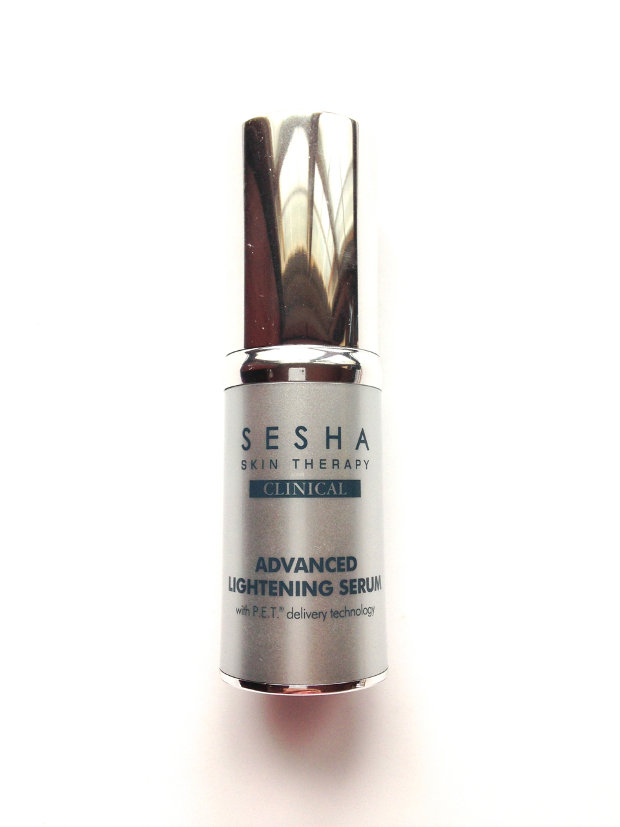 This Lightening serum is a 2% Hydroquinone-based lightening treatment. Sesha also makes one without hydroquinone. (Many professional brands offer a Hydroquinone-free alternative to their HQ treatments.)
This Lightening serum is a 2% Hydroquinone-based lightening treatment. Sesha also makes one without hydroquinone. (Many professional brands offer a Hydroquinone-free alternative to their HQ treatments.)
Now, Hydroquinone is a controversial ingredient, which you can read about here. Where do I come down on this? I personally have no problem using it on myself, and I do not believe it poses a health risk at OTC concentrations (under 2%). Where it becomes a potential problem is for darker skin tones (Fitzpatrick Skin Types 3 or higher), because it can over-lighten. And skin that might be potentially sensitive to it.
My skin is not sensitive to it. I use Hydroquinone because almost nothing else works on me. My pigmentation is extremely stubborn and largely dermal in nature. In fact, I will be resorting to lasers to get rid of my spots later this year.
This serum also contains a bunch of other brightening ingredients: mulberry, skullcap (Scutellaria baicalensis, a Chinese herb that has brightening properties), licorice extract, kojic acid, lactic acid, niacinamide, and Vitamin C.
I use this serum only on my spots. Some HQ treatments are recommended only for night, because it may cause photosensitivity. However, I was indoors all day and I wear a generous amount of sunscreen daily. If I had been outside all day, I would have saved this for night.
3. Sesha Clinical Complex-C Serum
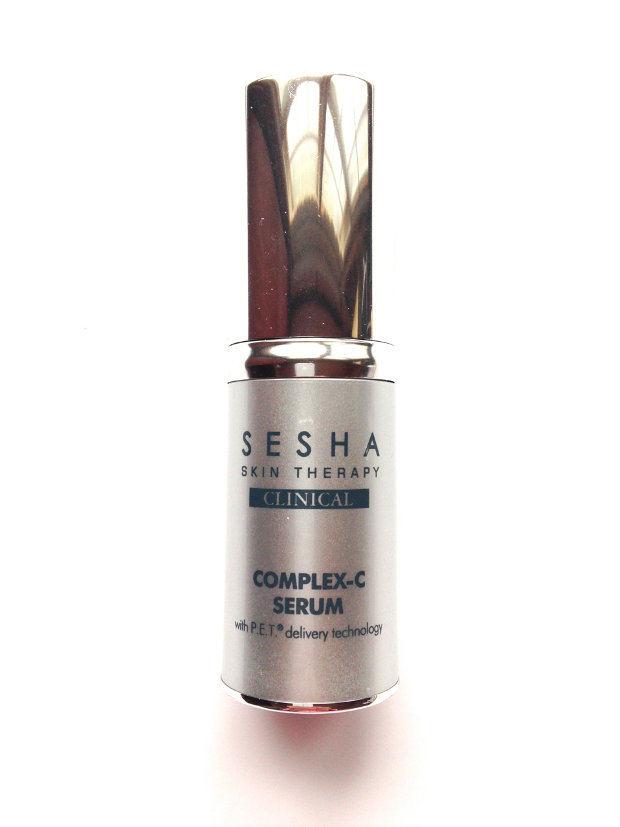 This is marketed as a Vitamin C serum, but it actually contains much more than Vitamin C. It also has a few peptides (Dermaxyl, Argireline), MDI complex (marine-derived glycosaminoglycans that inhibit the MMP enzymes that destroy collagen, glutathione (a powerful, important antioxidant often called the ‘Master Antioxidant’), green tea, grape seed, and more.
This is marketed as a Vitamin C serum, but it actually contains much more than Vitamin C. It also has a few peptides (Dermaxyl, Argireline), MDI complex (marine-derived glycosaminoglycans that inhibit the MMP enzymes that destroy collagen, glutathione (a powerful, important antioxidant often called the ‘Master Antioxidant’), green tea, grape seed, and more.
The Vitamin C is in the form of Ascorbyl Glucoside. The serum is a light fluid that is easy to spread and light in texture. So it can be layered easily with something else.
4. Revision Skincare Revox II Serum
I have written about this peptide serum before because it’s one that I love and works well on me. This is a neuropeptide serum by Revision Skincare, a line sold only in doctor’s offices. A neuropeptide serum acts like Botox by inhibiting the neuromuscular contractions that lead to deep wrinkles.
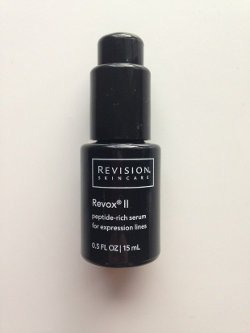 I use this serum on the elevens area (glabellar lines) between the brows and the horizontal forehead lines. On my elevens area, one tiny short line emerged in the last year. I’d like to prevent that line from getting deeper and longer, and to eliminate the appearance of the line temporarily. That’s what a neuropeptide serum does. The effect is not permanent, only temporary, and you have to keep on using the serum or the line returns.
I use this serum on the elevens area (glabellar lines) between the brows and the horizontal forehead lines. On my elevens area, one tiny short line emerged in the last year. I’d like to prevent that line from getting deeper and longer, and to eliminate the appearance of the line temporarily. That’s what a neuropeptide serum does. The effect is not permanent, only temporary, and you have to keep on using the serum or the line returns.
This serum contains 3 peptides that inhibit muscle contraction: Argireline (the most common one), SNAP-8, and SYN-AKE. It also has SYN-COLL (stimulates collagen production) and Palmitoyl Tetrapeptide-7 (suppresses the messengers that trigger inflammation).
5. HydrafacialMD ETX Eye Gel
 This eye gel is my favorite product in the HydrafacialMD line (I offer Hydrafacial treatments in my clinic). It’s meant to be an eye cream in a gel form. But I use this as an eye serum. It’s concentrated with humectants, which pre-hydrate my skin before eye cream application. I use a second, more emollient eye cream after this. The eye gel does a superb job of making the skin moist and soft, so eye cream goes on much more easily and smoothly. There is no tugging or drag.
This eye gel is my favorite product in the HydrafacialMD line (I offer Hydrafacial treatments in my clinic). It’s meant to be an eye cream in a gel form. But I use this as an eye serum. It’s concentrated with humectants, which pre-hydrate my skin before eye cream application. I use a second, more emollient eye cream after this. The eye gel does a superb job of making the skin moist and soft, so eye cream goes on much more easily and smoothly. There is no tugging or drag.
Everyone who has received this gel from me has loved it. It contains low and high molecular weight hyaluronic acid (a mix of both weights is better), seaweed extract (which is soothing and hydrating), and a soy peptide that tightens skin.
7. M.A.D. Skincare Illuminating Daily Moisturizer
M.A.D. Skincare is a clinical skincare line that takes a “cocktail” approach to skincare. Every product has a rich cocktail of goodies, which is another reason that I prefer professional skincare over retail when it comes to anti-aging solutions. You just get a lot more of the good stuff! And higher concentrations of it.
This moisturizer is part of the brightening line, but it also makes a good daily, daytime, anti-aging moisturizer due to its blend of Vitamin C.
 There’s an excellent group of brightening ingredients in here: Lumiskin, Betawhite, licorice, emblica fruit, mulberry, bearberry, and niacinamide.
There’s an excellent group of brightening ingredients in here: Lumiskin, Betawhite, licorice, emblica fruit, mulberry, bearberry, and niacinamide.
The Vitamin C blend is: BVOS-C Vitamin C, which is in the form of THDA (Tetrahexyldecyl Ascorbate), and Stay-C Vitamin C, which is in the form of a stabilized sodium salt of L-Ascorbic Acid packaged in liposomes that extend its stability and increase delivery into skin.
Apricot kernel oil provides a nice base emollient, and there are some other botanical extracts to round it out.
M.A.D. products are priced well too. Compared to retail products, they are very reasonable. And you get much more value. This moisturizer is $50 for 1.7 oz. Try finding this level of skincare with that amount in retail – you’d be hard-pressed to find it!
8. Dermalogica Super Sensitive Shield SPF 30
Super Sensitive Shield SPF 30 is Dermalogica’s mineral sunscreen (9% Zinc Oxide, 7% Titanium Dioxide). What I like about this sunscreen is its fluid texture. It’s a medium-weight liquid that flows easily and is therefore easy to spread. It also spreads in an even layer without much effort. Because it has some viscosity, it provides coverage over skin. Unlike other liquid sunscreens, it’s not super thin.
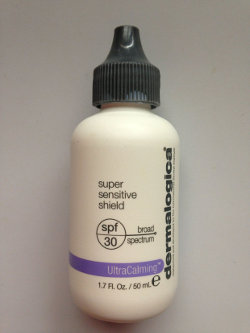 It also contains some helpful anti-inflammatory ingredients. So when skin is stressed or irritated, or when skin is recovering from a cosmetic procedure, this is an excellent salve in addition to protective shield for skin.
It also contains some helpful anti-inflammatory ingredients. So when skin is stressed or irritated, or when skin is recovering from a cosmetic procedure, this is an excellent salve in addition to protective shield for skin.
I also love to use anti-inflammatory products on my skin even when it’s not irritated or stressed. Why? Because chronic inflammation, which is present in all skin due to environmental stressors, is a major cause of aging over time. Anything you can do to reduce inflammation will slow down skin aging in the long run.
The only drawback to this sunscreen is the slightly white cast that it gives to skin. If you use less and rub it completely into skin, you reduce the cast. However, that also reduces its efficacy as a sunscreen. With mineral sunscreens, you don’t want to rub them into skin, making them disappear altogether. You should apply it like a layer of icing on a cake. It’s a physical deflector. The thinner the layer, the less protection you have. Obviously, you can’t cake it on, because it wouldn’t look good and it would most likely clog pores. But you need to strike a balance in the middle.
With chemical sunscreens (e.g. containing Avobenzone), you rub them into the skin. And that is because their mechanism of protection is different – they absorb UV energy, whereas mineral actives like Zinc Oxide and Titanium Dioxide, physically deflect UV rays off skin.
Related Articles:
- Anti-Aging Guide – an intro to various articles about anti-aging strategies on this site
- How To Treat Hyperpigmentation – a review of brightening ingredients
- Physical (Mineral) vs Chemical Sunscreens
Want articles & posts delivered straight to your inbox? Sign up for the weekly newsletter here.

